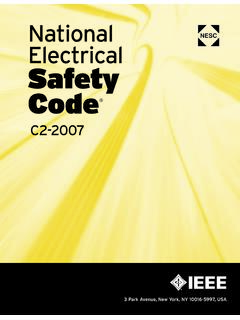Transcription of Chapter 3 Pre-Installation, Foundations and Piers - Oregon
1 Page 1 of 14 Chapter 3 Pre-Installation, Foundations and Piers 3-1 Pre-Installation Establishes the minimum requirements for the siting, design, materials, access, and installation of manufactured dwellings, accessory structures, accessory buildings, earthquake-resistant bracing, and wind and flood resistant anchoring. Design Loads Except as otherwise stated, the manufactured dwelling siting, foundation, and installation requirements contained in this code are based on the following: o Minimum soil bearing capacity is 1,000 PSF o Minimum pier capacity of 4,000 lbs. o Roof live load of 30 lbs PSF o Horizontal wind load of 15 PSF Note: Additional design loads are specified in Section Basic Requirements Regardless of the type of foundation system provided, the foundation must assure the manufactured dwelling has adequate support, a level floor, flush roof, flush floor, and flush wall connections at the marriage lines of multi-section manufactured dwellings.
2 3-2 Geographical Requirements Frost Line Conventional footings in freezing climates. See the definition of freezing climate in Chapter 2. If the building official determines that the installation is within a freezing climate region of this state, then convention footings must be placed below the frost line, See Table Foundation and retaining wall footings must be placed below the frost line. Insulated Foundations and monolithic slabs are permitted above the frost line when certain site-specific conditions and characteristics are taken into consideration. Special Snow Load Conditions Manufactured dwellings are built to the federal Manufactured Home Construction and Safety Standards, established by HUD.
3 Under this standard, Oregon 's snow roof live load is 20 PSF. If the home is built to a higher roof live load, the home must be installed and inspected according to the manufacturer's installation instructions for ridge beam marriage line connection, ground anchors, or when an aspect of the installation is not covered by this code. Page 2 of 14 Figure Typical Methods of Elevating Homes in Flood Hazard Areas This code is based upon a roof live load of 30 PSF. A building official may not require a manufactured dwelling to be built to a greater roof live load standard. Wind Resistant Anchoring As established by HUD, Oregon has one standard wind zone.
4 This code requires all manufactured dwelling installations to be anchored against the wind (new or secondary installations). New home installations must be anchored according the manufacturer s installation instructions. Secondary installations may be anchored according to the manufacturer s installation instructions, or according to Section of this code. Certain earthquake resistant bracing systems may comply with this requirement. Flood Hazard Areas Manufactured dwellings may be installed in flood hazard areas when they are elevated and anchored according to the Oregon Residential Specialty Code, Section Home installations shall be a minimum of 12 inches above the design flood elevation (DFE) according to Oregon Residential Specialty Code, Section Lowest floor is the bottom of the longitudinal chassis frame beam (bottom of the I-beam) in A Zones.
5 Anchoring the home shall be according to Oregon Residential Specialty Code, Appendix E, Section AE101 and AE102. Note: Effective April 1, 2010 all home installations shall be anchored against the wind. Typical wind anchoring provisions in most cases is equivalent to typical flood hazard area anchoring requirements. Page 3 of 14 Figure (b) Maximum Pier Height for Seismic Zone C & D1 Figure (a) Seismic Design Category Map Seismic Design Categories To identify the different levels of earthquake activity three seismic design categories have been established in Oregon as shown on Figure (a). o Design Category C low risk o Design Category D1- medium risk o Design Category D2 high risk Design category C and D1 Manufactured dwellings are limited to(1): o 3 feet in height for 75% of the under-floor area, and o 5 feet 7 inches for 25% of the under-floor area.
6 The fuel gas supply to the manufactured dwelling must be made with a minimum 6 foot flexible gas connector. Page 4 of 14 Figure (c) Maximum Pier Height for Seismic Zone D2 Design category D2 Manufactured dwellings are limited to(1): o 2 feet in height for 75 % of the under-floor area, and o 5 feet inches for 25 % of the under-floor area. The fuel gas supply to the manufactured dwelling must be made with a minimum 6 foot flexible gas connector. (1) The maximum height limitations identified may be exceeded when the support system is designed for the appropriate seismic design category by a registered design professional, or the manufacturer s Design Approval Primary Inspection Agency (DAPIA) approved plans, and accepted by the building official.
7 Earthquake Resistant Bracing When required, manufactured dwellings must be anchored or braced to resist seismic forces. The following are typical bracing systems: o Approved earthquake-resistant bracing system . o Approved anchoring system designed to resist seismic conditions. o Installing positive connection Piers at the main frame and anchoring with approved ground anchors. All prefabricated anchoring equipment must be approved for its intended use, and must be installed according to the equipment manufacturer s installation instructions. Anchoring Requirements New manufactured dwellings installations must anchored to one of the following: o According to the manufacturer s installation instructions.
8 This anchoring meets HUD s minimum installation requirements for ground anchors for Zone 1 in 24 CFR o Attachment to a foundation system , structural skirting, basement wall, or footing when designed by a registered design professional. o An earthquake resistant bracing system meeting the requirements in (1)(c). Page 5 of 14 Figure Typical Foundation Anchoring Secondary manufactured dwelling installations must be anchored to one of the following: o Manufacturer s installation instructions. o Foundation footing anchoring system .(2) o Connector plate anchoring. o See Figure (2) The code specifies that U-bar attachments must be at 11 feet on center.
9 This also applies to the expansion bolts, looped rebar, and any other acceptable anchoring point. The intent of the code is to require anchoring at 11 feet on center and within 1 foot of each end of the home. Page 6 of 14 3-3 Site and Stand Preparation Each site must be suitable for its intended use and acceptable to the building official based on this code and local land use regulations. Grading and Drainage Site grading and drainage must provide adequate drainage to divert water away from the manufactured dwelling, including roof run-off from manufactured dwellings, cabanas, and accessory buildings and structures. Lots and stands must be provided with adequate drainage to prevent standing water, excessive soil saturation, or erosion from becoming detrimental to the lot, stand, or any structures.
10 The ground within a 10 foot perimeter adjacent to a stand must be graded to a minimum fall of 1/2 inch per foot. Alternate grading methods may be used when needed and approved by the authority having jurisdiction. Stands Manufactured dwelling stands must be natural undisturbed soils or engineered fill. Stands must be free of grass, weeds, organic materials, and highly expansive, compressible or shifting soils. Soil Bearing Capacity For the purpose of this code, undisturbed soils have been determined to have a soil bearing capacity of 1,000 PSF. A stand with a soil bearing capacity of 1,000 PSF may be improved by: o Adding 6 inches of 3/4 inch minus crushed rock increases soil bearing capacity to 1,250 PSF.










